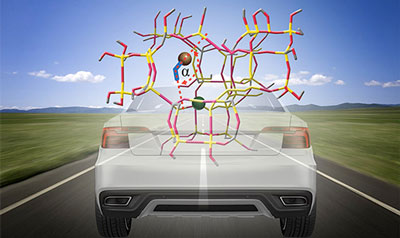| Jun 08, 2015 |
The shorter road to having it all: Fuel efficiency and cleaner exhausts
|
|
(Nanowerk News) Lean-burn engines operate under net oxidizing conditions to improve fuel efficiency by more than 25 percent, compared to conventional engines. Unfortunately, the added air causes the performance of conventional exhaust emission systems to deteriorate as the reduction of nitrogen oxides into harmless nitrogen is suppressed. The presence of nitrogen oxides (commonly abbreviated NOx) in the atmosphere can lead to smog, a health risk. For about 5 years, scientists have studied two extremely heat-stable, highly efficient catalysts for NOx conversion: Cu-SSZ-13, a zeolite material, and the isostructural Cu-SAPO-34.
|
|
Recently, scientists at Pacific Northwest National Laboratory and University College London analyzed the state of the science and future research directions of these catalysts in an extensive review article ("Recent advances in automotive catalysis for NOx emission control by small-pore microporous materials").
|
 |
| Experts from Pacific Northwest National Laboratory and University College London analyzed the state of the science and future research directions of two highly efficient, heat-stable catalysts for nitrogen oxides conversion.
|
|
The team was chosen because each scientist is a key player in automotive exhaust control catalysis research: Dr. Charles HF Peden and Dr. Janos Szanyi were members of the PNNL team that wrote the first publicly accessible paper on the high lean NOx reduction activity of Cu-SSZ-13, and Dr. Feng Gao has been instrumental to the synthesis and kinetic characterization of these catalysts in the past 4 years. Dr. Andrew Beale and Dr. Ines Lezcano-Gonzalez at UCL have done pioneering catalyst characterization work, which began shortly after the PNNL paper appeared.
|
|
In the 35-page review, the five authors discuss the current state of knowledge regarding the structure activity relationships of the two copper-based catalysts. They summarize the key findings on catalytic performance and efficacy studies that are providing new insights into how the catalysts can transform NOx and retain their performance even after high-temperature excursions. At the end of the review they also discuss issues that need to be addressed in future studies.
|
|
The researchers are continuing to delve into the challenges of removing pollutants from the exhaust pipes of the billion-plus cars running on the world's roads.
|

